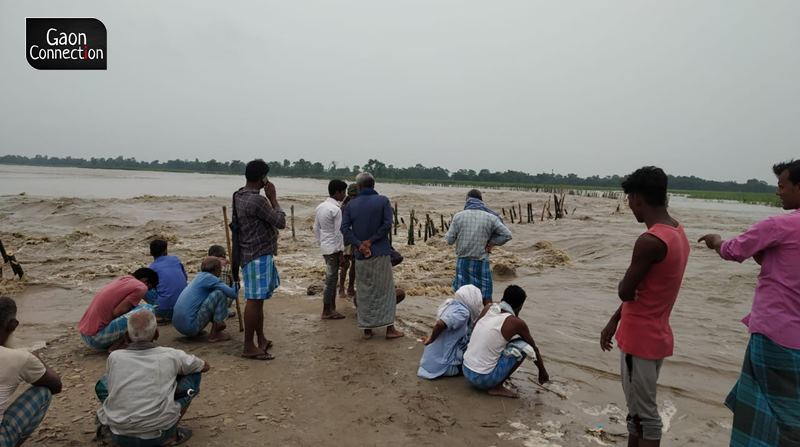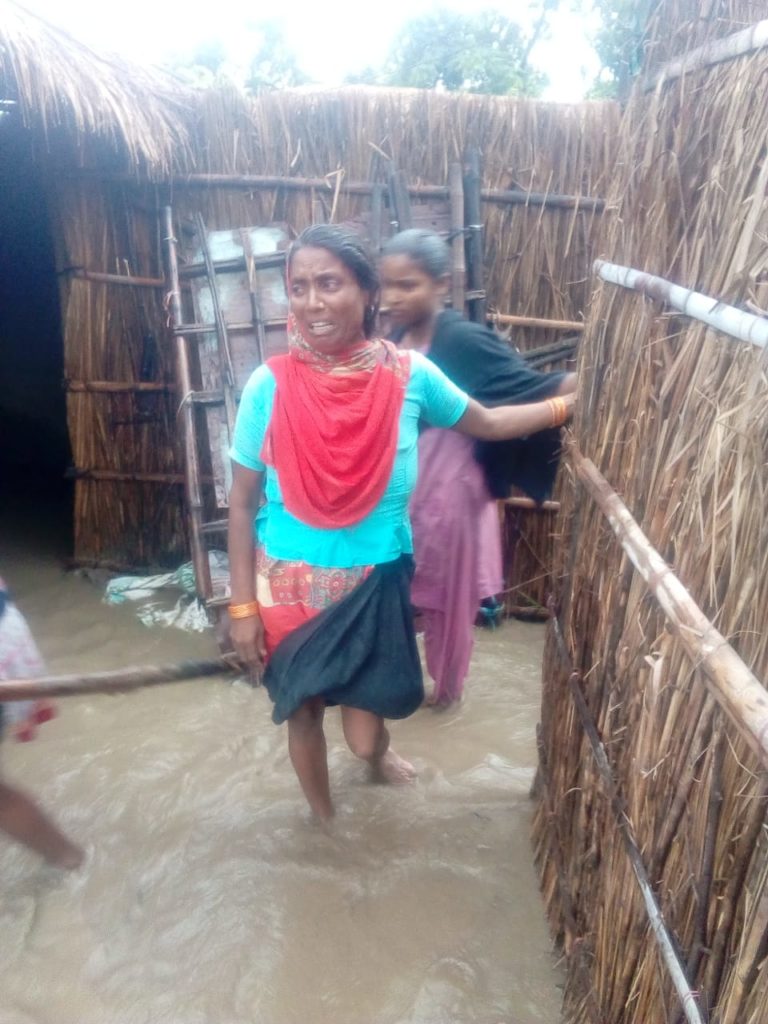Bihar Floods 2021: 90% flood-affected respondents lack access to safe drinking water, half the toilets broken, shortage of food, finds a survey
A joint rapid needs assessment survey in three worst flood-hit districts of Bihar — Pashchim Champaran, Purvi Champaran and Muzaffarpur — has found houses damaged, toilets washed away, rising hunger, loss of crops and cattle and several other impact of floods that have affected 15 districts of the state.


At least 800,000 people in 15 districts of Bihar are affected by floods and eight people have already lost their lives. Pashchim Champaran, Purvi Champaran and Muzaffarpur districts are the worst hit where hundreds of thousands villagers are displaced and forced to live on elevated roads or embankments to avoid the rising waters of rivers that are in spate in the state for past several days.
Since mid-June last month, the state has been facing floods, including flash floods in villages along the India-Nepal border. However, not much is known about the ground situation and official data on flood-hit population are also not being shared by the government authorities.
Now a rapid assessment survey conducted in inundated villages of the state shows the impact of floods on the local people. With a sample size of 318 households in 27 villages and six hospitals, 10 schools and five relief camps, the survey was conducted in three most affected districts of East Champaran, West Champaran and Muzaffarpur.
The survey report, ‘Joint Rapid Needs Assessment: Bihar Flood 2021’, has been jointly released on July 13 by Bihar Inter Agency Group and Sphere India.
Key findings of the rapid needs assessment
The survey report found that “non availability of safe drinking water was a major concern in the area, as 90% of the respondents did not have access to safe drinking water.”
Over half the respondents reported that the toilets in their area had been damaged and 33.5 per cent reported limited access to bathing space with privacy.
There has been an increase in open defecation in flood-affected areas. The surveyors found over 2,000 toilets in surveyed villages were damaged due to flooding, out of which 1,448 were fully damaged.
Out of the total survey respondents, the surveyors found 65 per cent were living on elevated road/embankment in Muzaffarpur and 12 per cent were living in such conditions in East Champaran.
Further, in East Champaran houses were either inundated or fully damaged for over half of the respondents. In Muzaffarpur, 70 per cent of the respondents houses were fully flooded or inundated. Meanwhile, in West Champaran 70 per cent houses were fully damaged and in need of rebuilding.
“The findings of rapid assessment report are an eye opener in the absence of any official data from the government and a factual iteration of why floods in Bihar cannot be seen from a single lens. Floods as a phenomenon has three interconnected and independent phases — pre, during and post. And it is critical to look at the three phases as a collective,” Eklavya Prasad, founder and managing trustee of Megh Pyne Abhiyan, told Gaon Connection. The non-profit has been working on the issue of floods and sanitation in Bihar for the past over 15 years.
Health impact and education woes
Out of the total 340 respondents, 22 per cent reported that their family member or they themselves were facing health problems. Almost 76 per cent said they were suffering from communicable disease, while nine per cent said they were COVID-19 positive.
Women and adolescent girls were one of the worst-hit in the floods. As per the rapid assessment report, “76% of adult women and adolescent girls reported unavailability of pads or other materials to be used during menstruation and 54% responded that they were hesitant to dispose pads/clothes and they have been disposing menstrual waste in open areas”.
Also Read: Bihar floods: An annual blame game between India and Nepal
Almost half the respondents complained there was no waste collection mechanism in their area and all the waste was generally thrown out on roads or burned.
The survey found that majority of the respondents in affected area had a major concern regarding education due to stopping of classes in the COVID-19 pandemic. Almost 22 per cent people reported that schools were not accessible and 27 per cent said that online classes were not happening due to electricity failure. Another 37 per cent respondents also reported infrastructure damages in schools due to floods.
Nutrition challenge and livelihood loss
According to the data gathered from the joint rapid needs assessment, food availability in flood-hit areas was a big concern. Slightly more than half — 53 per cent — respondents did not have stored food grains and 78 per cent did not have access to vegetables and food items.
Almost 85 per cent of the respondents felt not having enough food in the flood was a major concern. The assessment also found around 60.4 per cent of the surveyed households did not have adequate cooking utensils. Over 95 per cent of the respondents shared that food was the most urgent relief needed.
The rapid assessment found nearly 90 per cent of households reporting damage to farm lands due to destruction of crops and 26 per cent also reported loss of livestock/cattle.
Also Read: IMD warns of flash floods in Bihar’s Pashchim Champaran; entire villages evacuated
Bihar Floods 2021
Several districts in the state have been hit hard by floods this year. The Bagmati, Gehumi, and Kamla rivers have been in full spate for nearly a fortnight in Darbhanga district. Officials reported 79 villages across six blocks in the district have been affected by floods and a population of 58,000 has been impacted.
Flash floods have repeatedly hit East Champaran district since water levels of the river Gandak have increased due to the very heavy rainfall. In the district, at least 45,061 residents of 52 villages have so far been affected by the floods.
“Small and seasonal trans-boundary rivers bringing floods in districts along the India-Nepal border due to incessant rains in their respective upper catchments is a definitive indication that flood in Bihar is definitely not of a uniform character and we attach importance to all forms of floods and the causal factors,” said Prasad.

This southwest monsoon, Bihar has been pounded by extremely heavy rainfall. Between June 1 and July 10 this year, the state received ‘large excess’ rainfall of 69 per cent. As of July 15, the state is in the ‘excess’ rainfall category with rainfall departure of 46 per cent above normal, as reflected in the India Meteorological Department’s data.
Further in this monsoon season (June 1-July 15), its Pashchim Champaran district has received 194 per cent more than normal rainfall. Darbhanga, Madhubani, Supaul, Siwan, Saran, Vaishali, Samastipur and Bhahua have also received ‘large excess’ rainfall of 111 per cent, 78 per cent, 73 per cent, 71 per cent, 77 per cent, 64 per cent, 77 per cent and 70 per cent, respectively.
Predictably, several of these districts are facing floods.
Report recommendations
Based on the survey and detailed interactions with flood-hit people, the rapid assessment report has listed down immediate, mid-term and long-term recommendations. The most immediate measure is providing safe drinking water to flood-affected population.
“Immediate water supply through tankers should be mobilized in affected villages… Point-of-use chlorine drops/ tablets should be made available with proper education on its use, in order to increase availability of potable water for the time being,” reads the report. It also suggests immediate fixing of broken water supply systems such as hand pumps, tubewells, etc.
Also Read: Hope floats in flood-hit Bihar as Tika Wali Naav ensures COVID vaccination in marooned villages
The report also recommends immediate provision of temporary or mobile toilets and suggests “panchayat should take responsibility of cleaning and maintaining these facilities, along with provision of adequate water and lighting at night.” Debris, agriculture waste, animal carcass and other hazardous waste should be cleaned, considering COVID-19 guidelines, it adds.
Authors of the report also demand that the functionality of health centres must be maintained as there are chances of outbreak of diseases immediately and in the prevailing pandemic. Access to services like routine immunisation and outpatient consultations must be ensured. Mobile Van Health Facilities should be provided in hard-to-reach areas, recommends the assessment report.
Meanwhile, Prasad stressed it was time to seriously begin work towards developing flood resilient habitat as per the diverse flood typologies in Bihar. Flood resilient habitat needs to be accepted and adapted, otherwise we will continue to encounter issues pertaining to drinking water, sanitation, housing, livelihoods, education, health, and more in the future, he warned.

